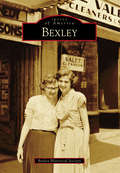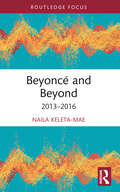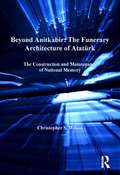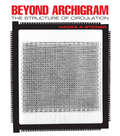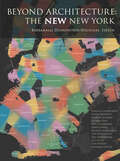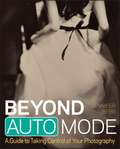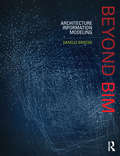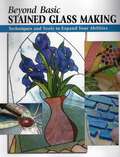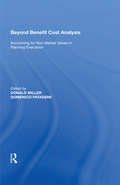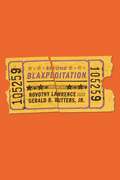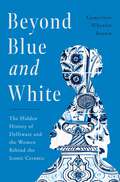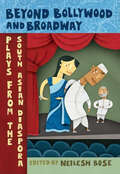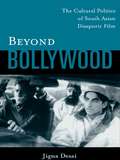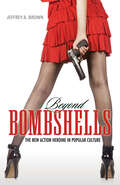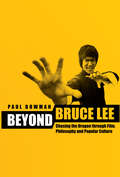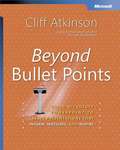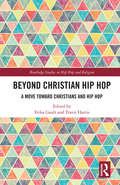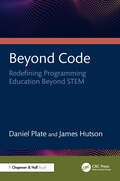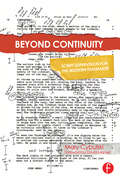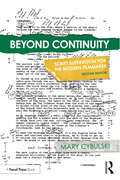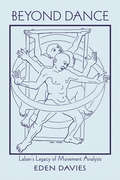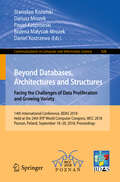- Table View
- List View
Bexley
by Bexley Historical SocietyFounded in 1908, Bexley is one of the earliest suburbs of Columbus, but it was settled by Native Americans long before Ohio became a state and Columbus its capital. Bexley packs a wealth of history and culture into less than two and a half square miles. It has been home to governors, award-winning authors, artists, movie stars, business leaders, and a famed aviatrix. Bexley has a long history of diversity and inclusion, welcoming people of all faiths and ethnicities. Hemmed in on all sides by the city of Columbus, Bexley has still been able to maintain a unique economic vitality characterized by businesses of all types for over 100 years. Just as notable is the city's wide array of churches and synagogues, as well as high-quality public and private educational institutions, including Capital University, that educate students from grammar school through graduate studies.
Beyoncé and Beyond: 2013–2016 (Routledge Advances in Theatre & Performance Studies)
by Naila Keleta-MaeThis book examines three years of Beyoncé’s career as a pop mega star using critical race, feminist and performance studies methodologies. The book explores how the careful choreography of Beyoncé’s image, voice and public persona, coupled with her intelligent use of audio and visual mediums, makes her one of the most influential entertainers of the 21st century. Keleta-Mae proposes that 2013 to 2016 was a pivotal period in Beyoncé’s career and looks at three artistic projects that she created during that time: her self-titled debut visual album Beyoncé, her video and live performance of "Formation," and her second visual album Lemonade. By examining the progression of Beyoncé’s career during this period, and the impact it had culturally and socially, the author demonstrates how Beyoncé brought 21st century feminism into the mainstream through layered explorations of female blackness. Ideal for scholars and students of performance in the social and political spheres, and of course fans of Beyoncé herself, this book examines the mega superstar’s transition into a creator of art that engages with Black culture and Black life with increased thoughtfulness.
Beyond Anitkabir: The Construction and Maintenance of National Memory
by Christopher S. WilsonThere have been five different settings that at one time or another have contained the dead body of Mustafa Kemal Atatürk, organizer of the Turkish War of Independence (1919-1923) and first president of the Republic of Turkey. Narrating the story of these different architectural constructions - the bedroom in Dolmabahçe Palace, Istanbul, where he died; a temporary catafalque in this same palace; his funeral stage in Turkey’s new capital Ankara; a temporary tomb in the Ankara Ethnographic Museum; and his permanent and monumental mausoleum in Ankara, known in Turkish as ’Anitkabir’ (Memorial Tomb) - this book also describes and interprets the movement of Atatürk’s body through the cities of Istanbul and Ankara and also the nation of Turkey to reach these destinations. It examines how each one of these locations - accidental, designed, temporary, permanent - has contributed in its own way to the construction of a Turkish national memory about Atatürk. Lastly, the two permanent constructions - the Dolmabahçe Palace bedroom and Anitkabir - have changed in many ways since their first appearance in order to maintain this national memory. These changes are exposed to reveal a dynamic, rather than dull, impression of funerary architecture.
Beyond Archigram: The Structure of Circulation
by Hadas A. SteinerBeyond Archigram is the first study of the prehistory of digital representation to focus on the magazine Archigram, the magazine published in London irregularly between 1961 and 1970 and the name of the group that created it. Archigram is among the most significant phenomena to emerge in post-war architectural culture. The wired environments first advertised on its pages formulated an architectural vocabulary of metamorphosis and obsolescence that cross-pollinated industrial and digital technology at the same time as complex systems were becoming commercially available. Through archival, theoretical and visual analysis, Hadas Steiner explores the process through which this model was envisaged and disseminated within an international network of practitioners and shows how the assimilation of Archigram imagery set the course for the visual output of what are now commonplace tools in architectural practice. This book will provide a foundation for further inquiry into the integration of digital technology at every level of design.
Beyond Architecture: The NEW New York
by Barbaralee Diamonstein-SpielvogelA volume of new essays by a range of contributors—architectural critics, city planners, historians, scholars, journalists, and more—to commemorate the sixtieth anniversary of the passage of the New York City Landmarks Law, exploring the past, present, and future of historic preservation in America&’s great metropolis.Beyond Architecture: The New New York is a volume of new essays, never before in print, commissioned by the NYC Landmarks60 Alliance to commemorate the sixtieth anniversary of the passage of the New York City Landmarks Law. The 1965 law established the Landmarks Preservation Commission (LPC) and initiated the era of historic preservation in New York City (the largest city in the United States). Today (as of July 2024) the Landmarks Preservation Commission oversees more than 38,000 buildings and sites throughout New York City, and has designated 158 historic districts and extensions, 1,464 individual landmarks, 123 interior landmarks, and 12 scenic landmarks (for example, all of Central Park comprises one landmark).&“Honor our past, imagine our future&” is the axiom of the NYC Landmarks60 Alliance. The contributors have written essays with forward-looking visions and consider &“the future of the past&” in the twenty-first century. Each contributor is uniquely placed to understand and explore this challenging topic.Their individual essays explore varied aspects of the impact, legacy, and current and future status of historic preservation in New York City. All the essays are meant to inspire reflection, hope, and excitement about the future of the new New York, its complex history, and its never-ending transformation.The writers have moved beyond architecture to examine the past, present, and future of New York City with creative and careful analyses of the subject which will stimulate thought, discussion, and action as we move toward a new New York.Barbaralee Diamonstein-Spielvogel, EditorVishaan ChakrabartiJustin DavidsonAndrew DolkartThomas DyjaPaul GoldbergerAdam GopnikMichael KimmelmanGuy NordensonNat OppenheimerA. O. ScottLisa SwitkinRosemary Vietor
Beyond Auto Mode
by Jennifer BebbTake full advantage of your dSLR camera, and do it with confidenceMany people buy dSLR cameras for their flexibility, but find themselves so intimidated by all the options and controls that they rarely venture beyond the automatic mode. With a friendly tone and clear, understandable instruction, photographer and educator Jen Bebb introduces you to every mode and setting on your sophisticated dSLR. After thoroughly explaining shutter speed, aperture, depth of field, ISO, and basic composition, she offers direction on what each camera mode does and when it should be used. You'll gain the confidence to use the entire feature set you paid for.Beginning dSLR users are often intimidated by the scene, semi-automatic, and fully manual modes on their cameras; this guide gently explains each mode and settingUses a conversational tone and liberal examples to define and explain basic concepts including shutter speed, aperture, ISO, depth of field, and compositionCovers how each camera mode works and when to consider using itHelps those new to dSLR photography to gain confidence and begin taking advantage of all the flexibility a dSLR offersWritten by a professional photographer who is also known for her skill as an instructor, Beyond Auto Mode encourages new and less experienced dSLR users to take the next step toward creative control.
Beyond BIM: Architecture Information Modeling
by Danelle BriscoeBeyond BIM explores the vast and under-explored design potential undertaken by information modeling. Through a series of investigations grounded in the analysis of built work, interviews with leading practitioners, and speculative projects, the author catalogs the practical advantages and theoretical implications of exploiting BIM as a primary tool for design innovation. Organized by information type, such as geographic data, local code, or materials, each chapter suggests a realm of knowledge that can be harvested and imported into BIM to give meaningful specificity to architectural form and space. While highly sustainable, the work documented and envisioned in this book moves well beyond ‘normalization,’ to reveal inventive takes on contemporary practice. Beyond BIM serves as a primary resource for professional architects from practice, researchers and designers engaged in information related spatial design processes, as well as students and faculties of architecture schools in search of BIM design inspiration. Likewise, those highly attuned to computation and unconventional ways of creating form and space, particularly built outcomes that utilize BIM, will find this book meaningful and essential.
Beyond Basic Crocheting (How To Basics)
by Sharon Hernes Silverman Annie ModesittStep-by-step instructions supplemented by photographs and illustrations teach new techniques clearly and thoroughly. Beaded crochet, crocheting with wire, making motifs, felting, ripple stitch, and crocheting on the diagonal. Includes a variety of contemporary projects any crafter would be proud to make.
Beyond Basic Knitting (How To Basics)
by Leigh Ann BerryDetailed information that builds on basic knitting techniques. How-to instructions complete with color photographs. Includes essential skills review and knitting resources list.
Beyond Basic Stained Glass Making (How To Basics)
by Sandy AllisonCreative techniques to go beyond the fundamentals. Includes an illustrated review of basic skills and tools plus how to use new tools and new ways to use basic tools. Step-by-step instructions for making three intermediate-level projects.
Beyond Benefit Cost Analysis: Accounting for Non-Market Values in Planning Evaluation (Urban Planning And Environment Ser.)
by Domenico PatassiniIllustrated by case studies from Europe, North America and the Middle East, this book examines how non-market values can be identified, measured and incorporated into planning evaluation methodologies. The traditional means of assessing planning options, benefit-cost analysis, requires that all effects be expressed in monetary terms and this volume offers alternative approaches. It presents strategies for accomplishing the major purposes of planning evaluation - including the provision of an explicit, replicable basis for public assessment - in alternative ways. Growing demand for public involvement and for accountability in decision making requires better means for accommodating a broad range of concerns in planning evaluation. Methodologies examined include effectiveness-cost and multicriteria analysis, and the book explores how these have been applied in practice in developing special-issue plans, complex regional development strategies, and efforts to analyze the environmental justice implications of major infrastructure projects. Use of scenarios and problem structuring methods by stakeholder groups are also explored.
Beyond Blaxploitation (Contemporary Approaches to Film and Media Series)
by Gerald R. Butters Jr. Novotny LawrenceBeyond Blaxploitation, the first book-length anthology of scholarly work on blaxploitation film, sustains the momentum that blaxploitation scholarship has recently gained, giving the films an even more prominent place in cinema history. This volume is made up of eleven essays employing historical and theoretical methodologies in the examination of spectatorship, marketing, melodrama, the transition of novel to screenplay, and racial politics and identity, among other significant topics. In doing so, the book fills a substantial gap that exists in the black cinematic narrative and, more broadly, in film history. Beyond Blaxploitation is divided into three sections that feature original essays on a variety of canonical blaxploitation films and others that either influenced the movement or in some form represent a significant extension of it. The first section titled, “From Pioneer to Precursor to Blaxploitation,” centers on three films—Cotton Comes to Harlem, Watermelon Man, and Sweet Sweetback’s Baadasssss Song—that ignited the African American film cycle. The second section, “The Canon and the Not so Canon,” is dedicated to forging alternative considerations of some of the most highly regarded blaxploitation films, while also bringing attention to lesser-known films in the movement. The final section, “Was, Is, or Isn’t Blaxploitation,” includes four essays that offer significant insights on films that are generally associated with blaxploitation but contest traditional definitions of the movement. Moreover, this section features chapters that address industrial factors that led to the creation of blaxploitation cinema and highlight the limitations of the term itself. Beyond Blaxploitation is a much-needed pedagogical tool, informing film scholars, critics, and fans alike, about blaxploitation’s richness and complexity.
Beyond Blue and White: The Hidden History of Delftware and the Women Behind the Iconic Ceramic
by Genevieve Wheeler-BrownAn engaging work of cultural history that reveals the stories behind one of the world's most coveted and beloved ceramic.When over seventy-five pieces of rare and intriguing 17th and 18th century Delftware are rediscovered in an historic Manhattan townhouse, decorative art advisor and writer Genevieve Wheeler Brown quickly recognizes that, together, these pieces tell an amazing story. What begins as a curatorial exercise quickly evolves not only into an exploration of this colorful, expressive, and sometimes even humorous decorative art, coveted for hundreds of years, but also an unexpected uncovering of forceful female lives yet untold. Connecting the accounts of women across centuries, Beyond Blue and White allows us to craft a more complete picture of female experience through the lens of material culture. We meet female Delftware makers, including Barbara Rotteveel founder of &“The Three Bells&” Delftware factory in 1671. We are introduced to female Delftware patrons such as Queen Mary II, who found her means of expression while creating a vogue in the 17th century for Delft blue and white across royal courts. And then there are the female collectors beginning in the 19th century who saw the artistry and craft in these ceramics others had overlooked. Foremost among them was Mrs. J. Pierpont Morgan and Mrs. Cornelius Vanderbilt II who came together with fellow New York women and laid the groundwork for women in the museum world while preserving decorative arts with an educational mission. With illustrations of period objects, documents, maps, paintings, prints and drawings, Beyond Blue and White is a colorful celebration of an iconic decorative art and dynamic women living in extraordinary times. Wheeler-Brown's rich narrative encourages us to see beyond the dazzling cobalt glaze of Delftware to consider that these vessels are also our connection to a history with a fascinating group of women at its center.
Beyond Bollywood and Broadway: Plays from the South Asian Diaspora
by Neilesh BoseThis collection of 11 plays, from North America, the U.K., and South Africa—many published here for the first time—delves into the vibrant, cosmopolitan theatre of the South Asian diaspora. These original and provocative works explore the experience of diaspora by drawing on cultural references as diverse as classical Indian texts, adaptations of Shakespeare and Homer, current events, and world music, film, and dance. Neilesh Bose provides historical background on South Asian migration and performance traditions in each region, along with critical introductions and biographical background on each playwright.Includes works by Anuvab Pal, Aasif Mandvi, Shishir Kurup, Rahul Varma, Rana Bose, Rukhsana Ahmad, Jatinder Verma, Sudha Bhuchar and Kristine Landon-Smith, Ronnie Govender, Kessie Govender, and Kriben Pillay.
Beyond Bollywood: The Cultural Politics of South Asian Diasporic Film
by Jigna DesaiBeyond Bollywood is the first comprehensive look at the emergence, development, and significance of contemporary South Asian diasporic cinema. From a feminist and queer perspective, Jigna Desai explores the hybrid cinema of the "Brown Atlantic" through a close look at films in English from and about South Asian diasporas in the United States, Canada, and Britain, including such popular films as My Beautiful Laundrette, Fire, Monsoon Wedding, and Bend it Like Beckham.
Beyond Bombshells: The New Action Heroine in Popular Culture
by Jeffrey A. BrownBeyond Bombshells analyzes the cultural importance of strong women in a variety of current media forms. Action heroines are now more popular in movies, comic books, television, and literature than they have ever been. Their spectacular presence represents shifting ideas about female agency, power, and sexuality. Beyond Bombshells explores how action heroines reveal and reconfigure perceptions about how and why women are capable of physically dominating roles in modern fiction, indicating the various strategies used to contain and/or exploit female violence. Focusing on a range of successful and controversial recent heroines in the mass media, including Katniss Everdeen from The Hunger Games books and movies, Lisbeth Salander from The Girl with the Dragon Tattoo novels and films, and Hit-Girl from the Kick-Ass movies and comic books, Jeffrey A. Brown argues that the role of action heroine reveals evolving beliefs about femininity. While women in action roles are still heavily sexualized and objectified, they also challenge preconceived myths about normal or culturally appropriate gender behavior. The ascribed sexuality of modern heroines remains Brown's consistent theme, particularly how objectification intersects with issues of racial stereotyping, romantic fantasies, images of violent adolescent and preadolescent girls, and neoliberal feminist revolutionary parables. Individual chapters study the gendered dynamics of torture in action films, the role of women in partnerships with male colleagues, young women as well as revolutionary leaders in dystopic societies, adolescent sexuality and romance in action narratives, the historical import of nonwhite heroines, and how modern African American, Asian, and Latina heroines both challenge and are restricted by longstanding racial stereotypes.
Beyond Bruce Lee: Chasing the Dragon Through Film, Philosophy, and Popular Culture
by Paul BowmanIn order to understand Bruce Lee, we must look beyond Bruce Lee to the artist's intricate cultural and historical contexts. This work begins by contextualising Lee, examining his films and martial arts work, and his changing cultural status within different times and places. The text examines Bruce Lee's films and philosophy in relation to the popular culture and cultural politics of the 1960s and 1970s, and it addresses the resurgence of his popularity in Hong Kong and China in the twenty-first century. The study also explores Lee's ongoing legacy and influence in the West, considering his function as a shifting symbol of ethnic politics and the ways in which he continues to inform Hollywood film-fight choreography. Beyond Bruce Lee ultimately argues Lee is best understood in terms of "cultural translation" and that his interventions and importance are ongoing.
Beyond Buds
by Ed Rosenthal David DownsBeyond Buds is a handbook to the future of marijuana. Prohibition's end has led to a technological revolution that's generated powerful medicines and products containing almost zero carcinogens and little smoke. Marijuana icon Ed Rosenthal and leading cannabis reporter David Downs guide readers through the best new consumer products, and demonstrate how to make and use the safest, cleanest extracts. Beyond Buds details how award-winning artisans make hash and concentrates, and includes modern techniques utilizing dry ice and CO2. The book is a primer on making kief, water hash, tinctures, topicals, edibles, and other extracts from cannabis leaves, trim, and bud bits, and it goes on to explore and simplify the more exotic and trendy marijuana-infused products, such as butane hash oil (BHO), shatter, wax, and budder. More complex than lighting a joint, these innovative products call for new accessories - special pipes, dabbing tools, and vaporizers - all of which are reviewed and pictured in the book. Beyond Buds expands on Rosenthal's previous book Ask Ed: Marijuana Gold - Trash to Stash. Completely updated with full-color photographs that are both "how-to" guides and eye candy, this book enables not only the health-conscious toker but also the bottom line-driven cultivator.
Beyond Bullet Points: Using Microsoft® PowerPoint® to Create Presentations That Inform, Motivate, and Inspire
by Cliff AtkinsonUnload those boring, bullet-riddled slides--and unlock the amazing story buried in your presentation! In BEYOND BULLET POINTS, communications expert Cliff Atkinson shares his innovative three-step system for increasing the impact of your communications with Microsoft PowerPoint. He guides you, step by step, as you discover how to combine the tenets of classic storytelling with the power of the projected media to create a rich, engaging experience. He walks you through his easy-to-use templates, plus 50 advanced tips, to help build your confidence and effectiveness--and quickly bring your ideas to life! FOCUS: Learn how to distill your best ideas into a crisp and compelling narrative. CLARIFY: Use a storyboard to clarify and visualize your ideas, creating the right blend of message and media. ENGAGE:Move from merely reading your slides to creating a rich, connected experience with your audience--and increase your impact! Inside!: See sample storyboards for a variety of presentation types--including investment, sales, educational, and training.
Beyond Christian Hip Hop: A Move Towards Christians and Hip Hop (Routledge Studies in Hip Hop and Religion)
by Erika D. Gault Travis HarrisChristians and Christianity have been central to Hip Hop since its inception. This book explores the intersection of Christians and Hip Hop and the multiple outcomes of this intersection. It lays out the ways in which Christians and Hip Hop overlap and diverge. The intersection of Christians and Hip Hop brings together African diasporic cultures, lives, memories and worldviews. Moving beyond the focus on rappers and so-called "Christian Hip Hop," each chapter explores three major themes of the book: identifying Hip Hop, irreconcilable Christianity, and boundaries.There is a self-identified Christian Hip Hop (CHH) community that has received some scholarly attention. At the same time, scholars have analyzed Christianity and Hip Hop without focusing on the self-identified community. This book brings these various conversations together and show, through these three themes, the complexities of the intersection of Christians and Hip Hop. Hip Hop is more than rap music, it is an African diasporic phenomenon. These three themes elucidate the many characteristics of the intersection between Christians and Hip Hop and our reasoning for going beyond "Christian Hip Hop." This collection is a multi-faceted view of how religious belief plays a role in Hip Hoppas' lives and community. It will, therefore, be of great interest to scholars of Religion and Hip Hop, Hip Hop, African Diasporas, Religion and the Arts, Religion and Race and Black Theology as well as Religious Studies more generally.
Beyond Code: Redefining Programming Education Beyond STEM
by James Hutson Daniel PlateAI-powered coding tools are revolutionizing software development, transforming programming from a specialized skill into an accessible educational practice across disciplines. This book investigates how tools such as Cursor AI, GitHub Copilot, and Replit's Ghostwriter are dismantling traditional barriers to entry for learners—particularly those from non-STEM backgrounds—by enabling natural language code generation, intelligent debugging, and interactive, project-based learning. Bridging the gap between theoretical instruction and practical application, the book serves as both a guide and a critical framework for integrating generative AI into curricula. It highlights how these tools expand the boundaries of programming education by supporting interdisciplinary applications, from literary analysis to creative writing, thereby making coding relevant and actionable for students in the humanities and beyond. The book equips educators with the tools and strategies necessary to incorporate AI-assisted programming into diverse academic contexts by offering lesson plans and adaptable project models. This resource is essential for instructors seeking to demystify coding, promote inclusivity in technical learning, and reimagine the role of software literacy in the twenty-first-century classroom.
Beyond Continuity: Script Supervision for the Modern Filmmaker
by Cybulski MaryFirst published in 2013. A guide to the craft of script supervising, Beyond Continuity features practical instruction through real-world examples demonstrating and explaining the skills needed by a professional script supervisor. Mary Cybulski, one of Hollywood's premier script supervisors, imparts her sage wisdom as she walks you through the process of training and working as a professional script supervisor,, covering the basic skills of breaking down a script, taking notes on set, matching, cheating, determining screen direction, and knowing what the director, actors, and editor expect from a script supervisor. She also details many of the more subtle, but just as important skills- how to get a job, how to think like an editor, how to tell what is important in a script and on set, how to get along with the cast and crew, and how not to get overwhelmed when there is too much information to process.
Beyond Continuity: Script Supervision for the Modern Filmmaker
by Mary CybulskiA guide to the craft of script supervising, the updated second edition features practical instruction through real-world examples that demonstrate and explain the skills needed by a professional script supervisor. Author Mary Cybulski, one of Hollywood’s premier script supervisors, imparts her sage wisdom as she walks you through the process of training and working as a professional script supervisor, covering the basic skills of breaking down a script, taking notes on set, matching, cheating, determining screen direction, and knowing what the director, actors, and editor expect from a script supervisor. She also details many of the subtler, but just as important skills—how to get a job, how to think like an editor, how to tell what is important in a script and on set, how to get along with the cast and crew, and how not to get overwhelmed when there is too much information to process. This second edition has been fully updated throughout to address significant changes to workflow as script supervisors utilize new technologies, software, and apps. The book also provides brand new coverage on how the role varies when working on episodic TV, commercials, and lower budget film projects. Ideal for aspiring, early career, and established continuity and script supervisors, as well as filmmaking students wanting to gain a better understanding of script supervision and film continuity. An accompanying e-resource features downloadable versions of the various forms, templates, logs, and checklists used by professional script supervisors.
Beyond Dance: Laban's Legacy of Movement Analysis
by Eden DaviesBeyond Dance: Laban's Legacy of Movement Analysis offers students of dance and movement a brief introduction to the life and work of Rudolf Laban, and how this work has been extended into the fields of movement therapy, communications, early childhood development, and other fields. While many dance students know of Laban and his work as it applies to their field, few know the full story of how this technique has developed and grown. For many who enter into the fields of dance movement therapy, performance, and communications, there are valuable lessons to be learned from Laban and his follower's works. Beyond Dance offers a concise introduction to this world. Refreshingly free of jargon and easy to understand, the work offers dance students – and others interested in human movement – a full picture of the many possibilities inherent in Laban's theories. For many who will pursue careers 'beyond dance', this work will be a useful guidebook into related areas. This will be ideally suited to students of Laban movement theory in dance and movement therapy, and will be used in advanced courses in these areas as useful, brief introduction to the field.
Beyond Databases, Architectures and Structures. Facing the Challenges of Data Proliferation and Growing Variety: 14th International Conference, BDAS 2018, Held at the 24th IFIP World Computer Congress, WCC 2018, Poznan, Poland, September 18-20, 2018, Proceedings (Communications in Computer and Information Science #928)
by Dariusz Mrozek Stanisław Kozielski Paweł Kasprowski Bożena Małysiak-Mrozek Daniel KostrzewaThis book constitutes the refereed proceedings of the 14th International Conference entitled Beyond Databases, Architectures and Structures, BDAS 2018, held in Poznań, Poland, in September 2018, during the IFIP World Computer Congress.It consists of 38 carefully reviewed papers selected from 102 submissions. The papers are organized in topical sections, namely big data and cloud computing; architectures, structures and algorithms for efficient data processing; artificial intelligence, data mining and knowledge discovery; text mining, natural language processing, ontologies and semantic web; image analysis and multimedia mining.
